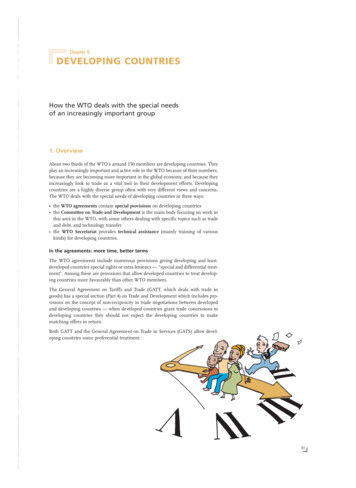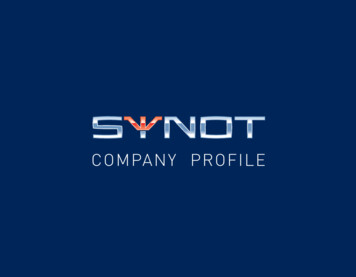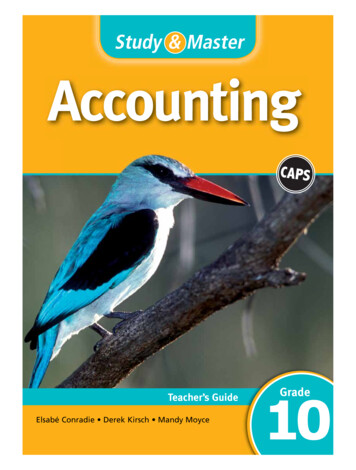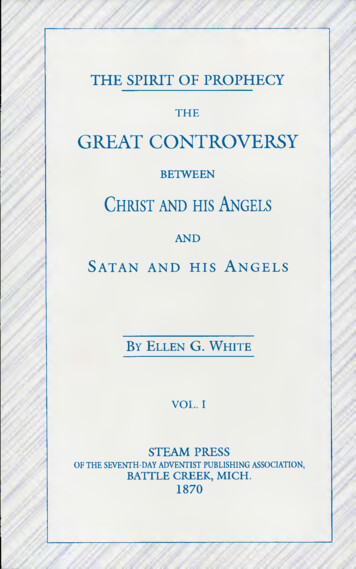
Transcription
8462 P 092 099 Q625/01/0814:48Page 93Chapter 6DEVELOPING COUNTRIESHow the WTO deals with the special needsof an increasingly important group1. OverviewAbout two thirds of the WTO’s around 150 members are developing countries. Theyplay an increasingly important and active role in the WTO because of their numbers,because they are becoming more important in the global economy, and because theyincreasingly look to trade as a vital tool in their development efforts. Developingcountries are a highly diverse group often with very different views and concerns.The WTO deals with the special needs of developing countries in three ways: the WTO agreements contain special provisions on developing countries the Committee on Trade and Development is the main body focusing on work inthis area in the WTO, with some others dealing with specific topics such as tradeand debt, and technology transfer the WTO Secretariat provides technical assistance (mainly training of variouskinds) for developing countries.In the agreements: more time, better termsThe WTO agreements include numerous provisions giving developing and leastdeveloped countries special rights or extra leniency — “special and differential treatment”. Among these are provisions that allow developed countries to treat developing countries more favourably than other WTO members.The General Agreement on Tariffs and Trade (GATT, which deals with trade ingoods) has a special section (Part 4) on Trade and Development which includes provisions on the concept of non-reciprocity in trade negotiations between developedand developing countries — when developed countries grant trade concessions todeveloping countries they should not expect the developing countries to makematching offers in return.Both GATT and the General Agreement on Trade in Services (GATS) allow developing countries some preferential treatment.93
8462 P 092 099 Q625/01/0814:48Page 94Other measures concerning developing countries in the WTO agreements include: extra time for developing countries to fulfil their commitments (in many of theWTO agreements) provisions designed to increase developing countries’ trading opportunitiesthrough greater market access (e.g. in textiles, services, technical barriers to trade) provisions requiring WTO members to safeguard the interests of developing countries when adopting some domestic or international measures (e.g. in anti-dumping, safeguards, technical barriers to trade) provisions for various means of helping developing countries (e.g. to deal withcommitments on animal and plant health standards, technical standards, and instrengthening their domestic telecommunications sectors).Legal assistance: a Secretariat serviceThe WTO Secretariat has special legal advisers for assisting developing countries inany WTO dispute and for giving them legal counsel. The service is offered by theWTO’s Training and Technical Cooperation Institute. Developing countries regularly make use of it.Furthermore, in 2001, 32 WTO governments set up an Advisory Centre on WTOlaw. Its members consist of countries contributing to the funding, and those receiving legal advice. All least-developed countries are automatically eligible for advice.Other developing countries and transition economies have to be fee-paying members in order to receive advice.Least-developed countries: special focusThe least-developed countries receive extra attention in the WTO. All the WTOagreements recognize that they must benefit from the greatest possible flexibility,and better-off members must make extra efforts to lower import barriers on leastdeveloped countries’ exports.Since the Uruguay Round agreements were signed in 1994, several decisions infavour of least-developed countries have been taken.Meeting in Singapore in 1996, WTO ministers agreed on a “Plan of Action for LeastDeveloped Countries”. This included technical assistance to enable them to participate better in the multilateral system and a pledge from developed countries toimproved market access for least-developed countries’ products.A year later, in October 1997, six international organizations — the InternationalMonetary Fund, the International Trade Centre, the United Nations Conference forTrade and Development, the United Nations Development Programme, the WorldBank and the WTO — launched the “Integrated Framework”, a joint technical assistance programme exclusively for least-developed countries.In 2002, the WTO adopted a work programme for least-developed countries. It contains several broad elements: improved market access; more technical assistance;support for agencies working on the diversification of least-developed countries’economies; help in following the work of the WTO; and a speedier membershipprocess for least-developed countries negotiating to join the WTO.At the same time, more and more member governments have unilaterally scrappedimport duties and import quotas on all exports from least-developed countries.94
8462 P 092 099 Q625/01/0814:48Page 95A ‘maison’ in Geneva: being present is important, but not easy for allThe WTO’s official business takes place mainly in Geneva. So do the unofficial contacts that can be equally important. But having a permanent office of representativesin Geneva can be expensive. Only about one third of the 30 or so least-developedcountries in the WTO have permanent offices in Geneva, and they cover all UnitedNations activities as well as the WTO.As a result of the negotiations to locate the WTO headquarters in Geneva, the Swissgovernment has agreed to provide subsidized office space for delegations fromleast-developed countries.A number of WTO members also provide financial support for ministers andaccompanying officials from least-developed countries to help them attend WTOministerial conferences.ON THE WEBSITE:www.wto.org trade topics development2. CommitteesWork specifically on developing countries within the WTO itself can be divided intotwo broad areas: (i) work of the WTO committees (this heading), and (ii) training forgovernment officials (and others) by the WTO Secretariat as mandated by the committee (next heading).Trade and Development CommitteeThe WTO Committee on Trade and Development has a wide-ranging mandate.Among the broad areas of topics it has tackled as priorities are: how provisionsfavouring developing countries are being implemented, guidelines for technicalcooperation, increased participation of developing countries in the trading system,and the position of least-developed countries.Member countries also have to inform the WTO about special programmes involving trade concessions for products from developing countries, and about regionalarrangements among developing countries. The Trade and Development Committeehandles notifications of: Generalized System of Preferences programmes (in which developed countrieslower their trade barriers preferentially for products from developing countries) preferential arrangements among developing countries such as MERCOSUR (theSouthern Common Market in Latin America), the Common Market for Easternand Southern Africa (COMESA), and the ASEAN Free Trade Area (AFTA).95
8462 P 092 099 Q625/01/0814:48Page 96Sub-committee on Least-Developed CountriesThe Sub-committee on Least-Developed Countries reports to the Trade andDevelopment Committee, but it is an important body in its own right. Its workfocuses on two related issues: ways of integrating least-developed countries into the multilateral trading system technical cooperation.The sub-committee also examines periodically how special provisions favouringleast-developed countries in the WTO agreements are being implemented.The Doha agenda committeesThe Doha Ministerial Conference in November 2001, added new tasks and somenew working groups. The Trade and Development Committee meets in “special sessions” to handle work under the Doha Development Agenda. The ministers also setup working groups on Trade, Debt and Finance, and on Trade and TechnologyTransfer. (For details see the chapter on the Doha Agenda.)3. WTO technical cooperationTechnical cooperation is an area of WTO work that is devoted almost entirely tohelping developing countries (and countries in transition from centrally-plannedeconomies) operate successfully in the multilateral trading system. The objective isto help build the necessary institutions and to train officials. The subjects covereddeal both with trade policies and with effective negotiation.Training, seminars and workshopsThe WTO holds regular training sessions on trade policy in Geneva. In addition, itorganizes about 500 technical cooperation activities annually, including seminarsand workshops in various countries and courses in Geneva.Targeted are developing countries and countries in transition from former socialistor communist systems, with a special emphasis on African countries. Seminarshave also been organized in Asia, Latin America, the Caribbean, Middle East andPacific.Funding for technical cooperation and training comes from three sources: the WTO’sregular budget, voluntary contributions from WTO members, and cost-sharing eitherby countries involved in an event or by international organizations.96
8462 P 092 099 Q625/01/0814:48Page 97The present regular WTO budget for technical cooperation and training is 7 millionSwiss francs.Extra contributions by member countries go into trust funds administered by theWTO Secretariat or the donor country. In 2004, contributions to trust funds totalled24 million Swiss francs.A WTO Reference Centre programme was initiated in 1997 with the objective of creating a network of computerized information centres in least-developed and developing countries. The centres provide access to WTO information and documentsthrough a print library, a CD-ROM collection and through the Internet to WTO websites and databases. The centres are located mainly in trade ministries and in theheadquarters of regional coordination organizations. There are currently 140 reference centres.Peaks’ and ‘escalation’: what are they?Tariff peaks: Most import tariffs are now4. Some issues raisedThe Uruguay Round (1986–94) saw a shift in North-South politics in the GATTWTO system. Previously, developed and developing countries had tended to be inopposite groups, although even then there were exceptions. In the run up to theUruguay Round, the line between the two became less rigid, and during the rounddifferent alliances developed, depending on the issues. The trend has continuedsince then.In some issues, the divide still appears clear — in textiles and clothing, and someof the newer issues debated in the WTO, for example — and developing countrieshave organized themselves into alliances such as the African Group and the LeastDeveloped Countries Group.In many others, the developing countries do not share common interests and mayfind themselves on opposite sides of a negotiation. A number of different coalitionsamong different groups of developing countries have emerged for this reason.The differences can be found in subjects of immense importance to developingcountries, such as agriculture.quite low, particularly in developed countries. But for a few products that governments consider to be sensitive — theywant to protect their domestic producers— tariffs remain high. These are “tariffpeaks”. Some affect exports from developing countries.Tariff escalation: If a country wants toprotect its processing or manufacturingindustry, it can set low tariffs on importedmaterials used by the industry (cutting theindustry’s costs) and set higher tariffs onfinished products to protect the goodsproduced by the industry. This is “tariffescalation”. When importing countriesescalate their tariffs in this way, they makeit more difficult for countries producingraw materials to process and manufacturevalue-added products for export. Tariffescalation exists in both developed anddeveloping countries. Slowly, it is beingreduced.This is a summary of some of the points discussed in the WTO.97
8462 P 092 099 Q625/01/0814:48Page 98Participation in the system: opportunities and concernsThe WTO agreements, which were the outcome of the 1986–94 Uruguay Round oftrade negotiations, provide numerous opportunities for developing countries tomake gains. Further liberalization through the Doha Agenda negotiations aims toimprove the opportunities.Among the gains are export opportunities. They include: fundamental reforms in agricultural trade phasing out quotas on developing countries’ exports of textiles and clothing reductions in customs duties on industrial products expanding the number of products whose customs duty rates are “bound” underthe WTO, making the rates difficult to raise phasing out bilateral agreements to restrict traded quantities of certain goods —these “grey area” measures (the so-called voluntary export restraints) are not reallyrecognized under GATT-WTO.In addition, liberalization under the WTO boosts global GDP and stimulates worlddemand for developing countries’ exports.But a number of problems remain. Developing countries have placed on the DohaAgenda a number of problems they face in implementing the present agreements.And they complain that they still face exceptionally high tariffs on selected products(“tariff peaks”) in important markets that continue to obstruct their importantexports. Examples include tariff peaks on textiles, clothing, and fish and fish products. In the Uruguay Round, on average, industrial countries made slightly smallerreductions in their tariffs on products which are mainly exported by developingcountries (37%), than on imports from all countries (40%). At the same time, thepotential for developing countries to trade with each other is also hampered by thefact that the highest tariffs are sometimes in developing countries themselves. Butthe increased proportion of trade covered by “bindings” (committed ceilings that aredifficult to remove) has added security to developing country exports.A related issue is “tariff escalation”, where an importing country protects its processing or manufacturing industry by setting lower duties on imports of raw materials and components, and higher duties on finished products. The situation isimproving. Tariff escalation remains after the Uruguay Round, but it is less severe,with a number of developed countries eliminating escalation on selected products.Now, the Doha agenda includes special attention to be paid to tariff peaks and escalation so that they can be substantially reduced.98
8462 P 092 099 Q625/01/0814:48Page 99Erosion of preferencesAn issue that worries developing countries is the erosion of preferences — specialtariff concessions granted by developed countries on imports from certain developing countries become less meaningful if the normal tariff rates are cut because thedifference between the normal and preferential rates is reduced.Just how valuable these preferences are is a matter of debate. Unlike regular WTOtariff commitments, they are not “bound” under WTO agreements and thereforethey can be changed easily. They are often given unilaterally, at the initiative of theimporting country. This makes trade under preferential rates less predictable thanunder regular bound rates which cannot be increased easily. Ultimately countriesstand to gain more from regular bound tariff rates.But some countries and some companies have benefited from preferences. Thegains vary from product to product, and they also depend on whether producers canuse the opportunity to adjust so that they remain competitive after the preferenceshave been withdrawn.The ability to adapt: the supply-sideCan developing countries benefit from the changes? Yes, but only if their economiesare capable of responding. This depends on a combination of actions: from improving policy-making and macroeconomic management, to boosting training andinvestment. The least-developed countries are worst placed to make the adjustmentsbecause of lack of human and physical capital, poorly developed infrastructures,institutions that don’t function very well, and in some cases, political instability.99
8462 P 100 112 Q625/01/0815:39Page 100
94 Other measures concerning developing countries in the WTO agreements include: extra timefor developing countries to fulfil their commitments (in many of the WTO agreements) provisions designed to increase developing countries’ trading opportunities through greater market access










